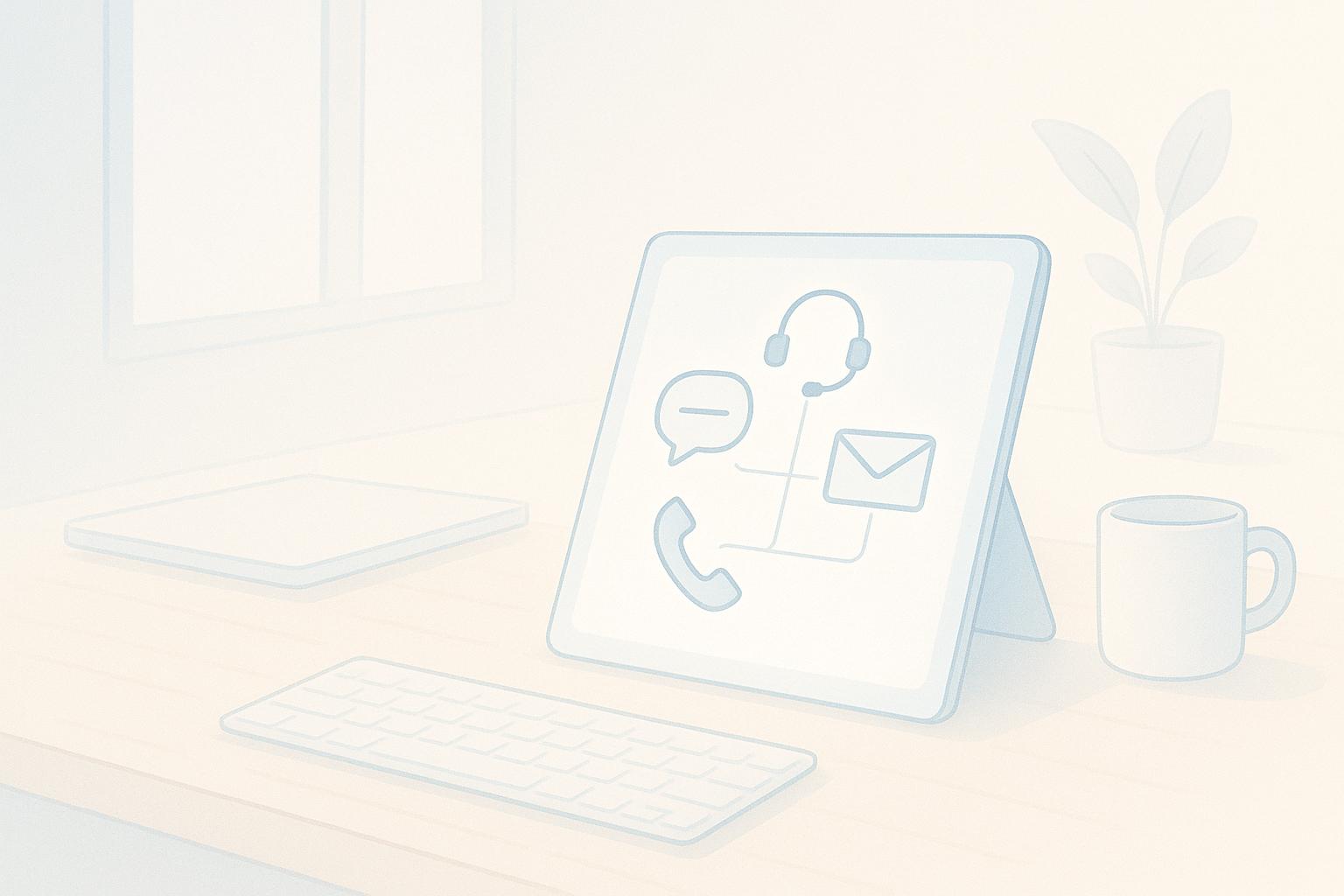A CRM (Customer Relationship Management) system helps businesses manage customer data, interactions, and services efficiently. It centralizes customer information, streamlines sales processes, and improves team collaboration. CRMs are essential for improving customer experiences, increasing sales, and guiding data-driven decisions.
Key Takeaways:
- What is a CRM? A tool to organize customer data and interactions for better service and sales.
- Types of CRMs:
- Sales & Service CRM: Automates sales, marketing, and customer support.
- Data Analysis CRM: Analyzes customer behavior and predicts trends.
- Team Communication CRM: Enhances collaboration across departments.
- Benefits:
- Better customer management with centralized data.
- Improved sales processes and marketing results.
- Increased staff efficiency through automation.
CRMs are available as cloud-based or on-premises systems, each with unique advantages. Choosing the right CRM depends on your business size, goals, and budget.
What is CRM? | Customer Relationship Management
3 Main CRM Categories
To pick the right CRM, it's essential to understand the specific goals and features of each type.
Sales and Service CRM
These CRMs handle everything from initial contact with a customer to ongoing support after a sale.
| Feature | Purpose | Business Impact |
|---|---|---|
| Sales Automation | Tracks leads and automates follow-ups | Saves time and increases conversions |
| Marketing Integration | Manages campaigns in one place | Ensures consistent customer communication |
| Service Management | Centralizes support data | Speeds up responses and improves service |
A great example is Zoho CRM, which helps businesses streamline their sales and marketing processes. Its ability to track every customer interaction and automate follow-ups has made it a favorite among sales teams looking to boost productivity.
Data Analysis CRM
Analytical CRMs take raw customer data and turn it into actionable insights.
- Customer Behavior Analysis: Monitors buying habits to anticipate future needs.
- Market Segmentation: Groups customers by traits for more focused marketing.
- Sales Forecasting: Analyzes past data to predict future sales trends.
- Performance Metrics: Evaluates how well sales and marketing strategies are working.
Team Communication CRM
Collaborative CRMs are designed to break down barriers between departments. By giving everyone access to the same customer data, they make teamwork smoother and customer interactions more consistent.
These systems shine in cross-departmental workflows:
- Marketing teams can share campaign outcomes directly with sales.
- Customer service teams can see full customer histories.
- Sales teams can check on support tickets and past interactions.
- Managers can track team performance and customer satisfaction.
Most collaborative CRMs also integrate easily with other tools through APIs. This ensures that all departments are aligned, delivering a seamless experience for customers no matter who they interact with.
CRM Business Advantages
Better Customer Management
A CRM system organizes customer data in one place, making it easier to manage relationships. Teams can provide personalized service by tracking interactions and understanding customer preferences.
| Benefit | Impact | Measurable Result |
|---|---|---|
| Data Centralization | One reliable source for customer information | Cuts response time by up to 40% |
| Interaction History | Full view of the customer journey | Boosts first-contact resolution rates |
| Customer Segmentation | Tailored communication strategies | Improves personalization efforts |
Sales Process Improvements
CRMs are not just about managing relationships - they also streamline sales processes. On average, businesses gain $8.71 for every dollar spent on CRM software.
Some key sales benefits include:
- Automated lead scoring and standardized processes that save time
- Real-time pipeline tracking for better forecasting
- Integration with other tools to connect workflows across departments
Marketing Results
CRMs tie marketing activities to measurable outcomes, helping teams fine-tune their strategies across various channels.
"Customer relationship management (CRM) serves to enhance a customer's overall experience. The term refers to an organization's principles, practices, and guidelines that it follows when interacting with its customers."
Marketing teams can use CRM data to:
- Segment campaigns and align messaging with sales for stronger engagement
- Monitor campaign performance and ROI across platforms
- Build marketing strategies based on data insights
Staff Efficiency
CRM tools increase productivity by offering quick access to important data and automating repetitive tasks.
| Feature | Efficiency Impact |
|---|---|
| Automated workflows and task management | Reduces manual labor by up to 70% |
| Centralized Communication | Breaks down information silos |
| Mobile Access | Provides real-time updates on the go |
These efficiency gains free up time for teams to focus on meaningful customer interactions, improving both service quality and sales outcomes.
sbb-itb-b22f30c
CRM Selection Guide
Choosing a CRM system involves understanding your business needs and comparing available options to find the best fit.
Requirements Analysis
Start by analyzing your company's unique requirements to ensure the CRM system enhances customer retention and improves sales processes. Here's what to consider:
| Business Aspect | Key Points to Evaluate |
|---|---|
| Business Scale | Current user base, customer volume, and growth plans |
| Core Operations | Sales workflows, service demands, and marketing strategies |
| Technology Setup | Compatibility with existing software and data systems |
| Budget | Costs for implementation, upkeep, and employee training |
Focus on solving current operational issues while ensuring the system can grow with your business.
Must-Have CRM Functions
A good CRM system should offer these essential features:
| Feature Category | Key Functions |
|---|---|
| Customer Management | Detailed profiles, segmentation tools |
| Sales Tools | Pipeline tracking, lead scoring, and opportunity management |
| Automation | Workflow streamlining and task scheduling |
| Reporting | Dashboards and performance analytics |
Once you've outlined your needs, look for a CRM that includes these features to meet your goals.
Online vs. Local CRM Options
After identifying the necessary features, decide between a cloud-based or on-premises CRM based on your operational priorities:
Advantages of Cloud-Based CRMs:
- Lower upfront costs and automatic updates
- Easy access from anywhere and minimal maintenance
Advantages of On-Premises CRMs:
- Greater control over data and enhanced security
- More customization options
Cloud-based solutions are becoming increasingly popular due to their flexibility and lower maintenance demands. When comparing vendors, give preference to those offering thorough training and reliable technical support to ensure a smooth implementation process.
Summary
A Customer Relationship Management (CRM) system plays a central role in how businesses manage their customer interactions and improve service delivery.
As discussed earlier, CRM systems come in three main types:
- Operational CRMs: Focus on simplifying daily customer interactions.
- Analytical CRMs: Help businesses make informed decisions using data.
- Collaborative CRMs: Improve teamwork across departments.
"CRM is not just a technology, but a business strategy that aims to create long-term relationships with customers".
Modern CRM platforms leverage AI and machine learning to deliver tailored customer experiences. These advancements allow businesses to:
- Understand customer behavior and turn it into actionable strategies.
- Automate repetitive tasks and documentation processes.
- Boost team productivity and foster better collaboration.
To get the most out of a CRM system, companies should focus on keeping data updated and providing proper training for their teams. This approach ensures the CRM becomes a powerful business strategy rather than just another tool.
Some important CRM metrics to track include customer retention, conversion rates, and team efficiency.
Now, with a solid grasp of CRM’s capabilities and strategic importance, we’ll dive into some frequently asked questions about its implementation and use.
FAQs
Here are answers to some common questions about CRM systems, shedding light on their role and advantages for businesses.
How does CRM help sales teams?
CRM systems make life easier for sales teams by automating tasks and keeping customer data organized. They handle things like tracking communications, sending lead follow-up reminders, and storing all customer information in one place. Plus, they deliver an average ROI of $8.71 for every dollar spent, making them a smart choice for boosting sales efficiency.
What is operational, strategic, and analytical CRM?
These three types of CRM systems serve different purposes in managing customer relationships:
- Operational CRM: Focuses on automating customer-facing tasks and daily operations.
- Strategic CRM: Connects customer strategies with broader business goals.
- Analytical CRM: Examines customer data to identify trends and behaviors.
What are the types of CRM systems?
CRM systems come in four main types, each tailored to specific business needs:
| CRM Type | Primary Focus |
|---|---|
| Operational | Managing daily interactions and automating tasks |
| Analytical | Gaining insights from customer data |
| Collaborative | Improving communication and data sharing |
| Strategic | Aligning customer management with business goals |
Operational, analytical, and collaborative CRMs handle specific tasks, while strategic CRM focuses on long-term alignment with business objectives. Knowing these differences can help you choose the best CRM for your needs, as outlined earlier in this guide.



